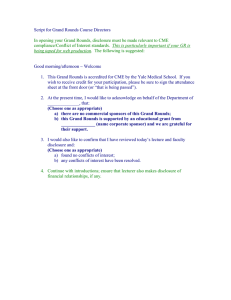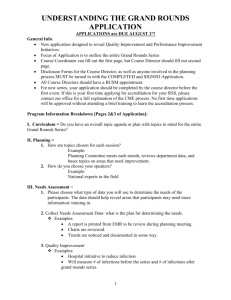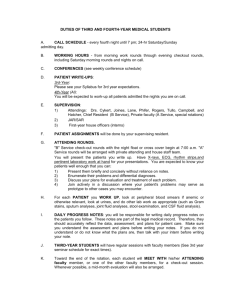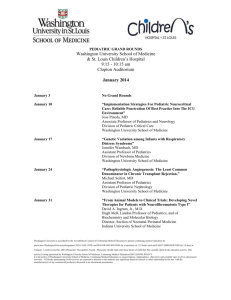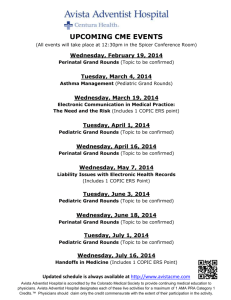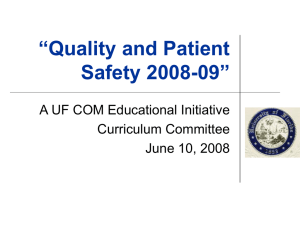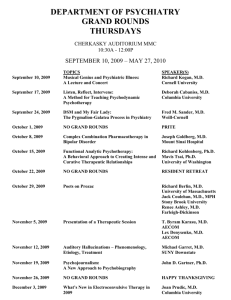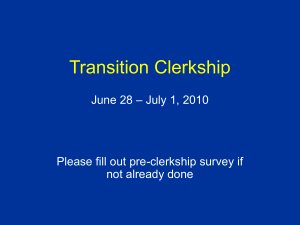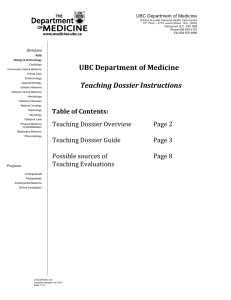DRAFT TIMELINE AND COURSE ACTIVITIES
advertisement
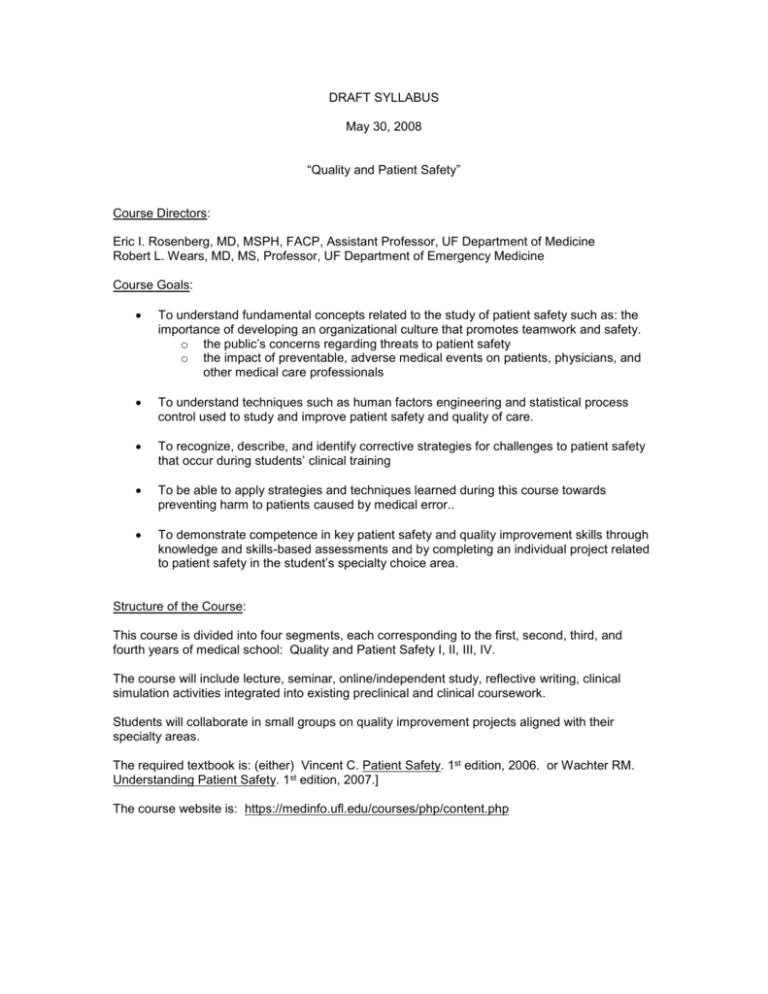
DRAFT SYLLABUS May 30, 2008 “Quality and Patient Safety” Course Directors: Eric I. Rosenberg, MD, MSPH, FACP, Assistant Professor, UF Department of Medicine Robert L. Wears, MD, MS, Professor, UF Department of Emergency Medicine Course Goals: To understand fundamental concepts related to the study of patient safety such as: the importance of developing an organizational culture that promotes teamwork and safety. o the public’s concerns regarding threats to patient safety o the impact of preventable, adverse medical events on patients, physicians, and other medical care professionals To understand techniques such as human factors engineering and statistical process control used to study and improve patient safety and quality of care. To recognize, describe, and identify corrective strategies for challenges to patient safety that occur during students’ clinical training To be able to apply strategies and techniques learned during this course towards preventing harm to patients caused by medical error.. To demonstrate competence in key patient safety and quality improvement skills through knowledge and skills-based assessments and by completing an individual project related to patient safety in the student’s specialty choice area. Structure of the Course: This course is divided into four segments, each corresponding to the first, second, third, and fourth years of medical school: Quality and Patient Safety I, II, III, IV. The course will include lecture, seminar, online/independent study, reflective writing, clinical simulation activities integrated into existing preclinical and clinical coursework. Students will collaborate in small groups on quality improvement projects aligned with their specialty areas. The required textbook is: (either) Vincent C. Patient Safety. 1st edition, 2006. or Wachter RM. Understanding Patient Safety. 1st edition, 2007.] The course website is: https://medinfo.ufl.edu/courses/php/content.php Specific Course Activities: Quality and Patient Safety I (August 2008 – June 2009) (EPC, IFH) Online Module I: “The scope and gravity of adverse events” (A. Stevens) Online Module II: “The scope of quality problems in the U.S. medical system” (E. Rosenberg) Quality and Safety Student Grand Rounds I: “The Impact of Medical Harm on Patients and Families” (EPC-1) Workshop I: “Review of Readings and Grand Rounds I” (EPC-1) o “Executive Summary: To Err is Human” (IOM 1999) o “When Doctors Make Mistakes” (Atul Gawande) o Excerpts from executive summaries of IOM/Quality Chasm Reports o “The Nature and Frequency of Medical Errors” (Wachter, Ch 1) Quality and Safety Student Grand Rounds II: “The Impact of Medical Harm on Physicians and other Medical Professionals” (EPC) Workshop II: “Reflective Writing on Quality/Safety” (EPC-2) Clinical Skills Exam Module Quality and Patient Safety II (August 2008 – June 2009) (EPC, Ethics, Pathology, EBM) Online Module III: “Introduction to Root Cause Analysis” Online Module IV: “Introduction to Quality Improvement” Workshop III: “Root Cause Analysis Exercise” (EBM) Workshop IV: “Quality Improvement Concepts” Workshop V: “The Hidden Patient Safety Curriculum: Current Reality on the Wards and in Clinic” / Ethical Issues Surrounding Safety (MS-4, residents, faculty) (Clerkship Orientation 2009; Ethics) Workshop VI: “Improving Interdisciplinary Communication” (Winter/Crawford) Workshop VII: “Improving Patient Communication: Assessing Barriers to Care” (EPC-3) Lecture I: “The Tort System and its Impact on Quality Improvement” (Ethics; J. Osgard SUF Self Insurance Trust Fund) Quality and Safety Student Grand Rounds III: “Interdisciplinary Communication and Teamwork Challenges” (outside speaker – David Mussen, Ottawa physician, PhD) Quality and Safety Student Grand Rounds IV: “Lessons from Industry” (outside speaker – Emily Patterson, Ohio State Univ – NASA/healthcare) Clinical Skills Exam Quality and Patient Safety III (July 2008 – June 2009) (the clerkships) Students may consider a menu of options to choose from during the year to satisfy requirements We want to encourage a high degree of flexibility. Clerkship Lecture Series (OnLine Video) o 4 Themes: (involvement of multidisciplinary faculty from SUF, VA) Role of Hospital Quality Depts. Role of Nursing in QI Avoidance of Medication Errors Laboratory / Radiographic Errors Clerkship Seminar Series: “Case Studies in Patient Safety” o o Presentation of Actual/Averted Errors with mock root cause analyses Presentation of Quality Data from clinics/OR/hospital with discussion of methods of performance improvement Patient Safety Rounds (GAVAMC) Clinical Skills Exam Quality and Patient Safety IV (July 2008 – June 2009) (the Sub-I rotation) Workshop VIII: “Clinical Decision Making: “How Doctors Think” Online Module V: “Disclosing Errors to Patients” Online Module VI: “Anticipating Error to Avert Harm” Simulation Exercises o Harrell Professional Development and Assessment Center “Disclosing Errors to Patients and Families” “Discussion of Errors on Rounds” o Operating Room Simulation “Spot the Error” Exercise (John Armstrong, Jane Carthy) Anesthesiology simulators o Bedside Procedure Simulation Workshop IX: “The Hidden Residency Patient Safety Curriculum” Development of CQI Project (with input from Physician Quality Directors) o Research/Write about quality of care issues surrounding a disease, procedure, patient population o Adopt a CQI project; participate in data collection, analysis of ongoing research at SUF Evaluation of Student Achievement: Attendance at all required course activities Completion of Clinical Skills Exam at close of 1st, 2nd, 3rd, and 4th year Evaluation of progress and Completion of Reflective Portfolio Completion of Quality Improvement Project
